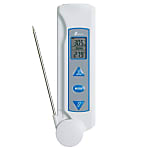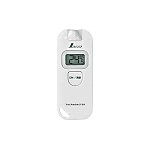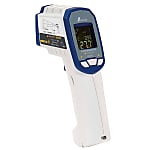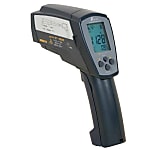(!)NOTE : Windows 7 users won’t be able to use some latest features of eCatalog/WOS since Microsoft is ending support for Windows 7 on 14 Jan, 2020. Please upgrade your system for uninterrupted services.
- Scheduled Maintenance Notice: This site will be unavailable due to scheduled maintenance from 6:30 19/1/2025 to 3:30 (IST) 20/1/2025. We apologize for the inconvenience.
- Notice of End of Sales for Economy Series Pneumatic Equipment Category. More information.
Thermometers/Hygrometers(Temperature Measuring Range:-35~1,500)
Brand |
|
|---|---|
| CAD |
|
| Days to Ship |
|
1 items
- Sort By
-
You can add up to 6 items per a category to the compare list.





Radiation Thermometer (laser point type)
SHINWASOKUTEI
[Features]
· Since it is a non-contact type, it can be used safely and hygienically.
· The measurement point can be seen at a glance using the laser point. * The measuring range is the center of the circle. (Actually approx. 2 cm below center)
· With backlight function.
[Applications]
· For various temperature measurements.Product Type Temperature Measuring Range(°C) Temperature minimal display(°C) Drip-proof and Waterproof function Operating Temperature Range(°C) Humidity Minimal Display(%RH) Measured humidity range(%RH) Heat Stroke Index display range(°C) Primary Color Color after discoloration Thermometer -35~1,500 -35 to 999.9: 0.1, Other: 1 - 0–50 - - - - - From: ₹ 26,561.95 Days to Ship: 11 Day(s) or more  11 Day(s) or more
11 Day(s) or more
| Brand |
|---|
| Product Series |
| From |
| Days to Ship |
| Product Type |
| Temperature Measuring Range(°C) |
| Temperature minimal display(°C) |
| Drip-proof and Waterproof function |
| Operating Temperature Range(°C) |
| Humidity Minimal Display(%RH) |
| Measured humidity range(%RH) |
| Heat Stroke Index display range(°C) |
| Primary Color |
| Color after discoloration |
You can add up to 6 items per a category to the compare list. | |
| Brand | SHINWASOKUTEI |
| Product Series | |
| From | ₹ 26,561.95 |
| Days to Ship | 11 Day(s) or more |
| Product Type | Thermometer |
| Temperature Measuring Range(°C) | -35~1,500 |
| Temperature minimal display(°C) | -35 to 999.9: 0.1, Other: 1 |
| Drip-proof and Waterproof function | - |
| Operating Temperature Range(°C) | 0–50 |
| Humidity Minimal Display(%RH) | - |
| Measured humidity range(%RH) | - |
| Heat Stroke Index display range(°C) | - |
| Primary Color | - |
| Color after discoloration | - |
Loading...
Configure
Specification/Dimensions
-
Product Type
- Thermometer
- Thermo-hygrometer
- Thermometer (External Sensor Type)
- Thermo-hygrometer (External Sensor Type)
- Core temperature thermometer
- Built-in thermometer
- Radiation thermometer
- Condensation Checker
- Thermometer (Installation Type)
- Thermo-hygrometer (Logger)
- Thermo-hygrometer_
- Heat Sensor
- Heat Stroke Index monitor
- Ultraviolet Meter
- Temperature Indicating Material For Temperature Management
- Other Accessory
- Soil acidity meter
-
Temperature Measuring Range(°C)
- -200 to 300
- -200~400/700/1000/1372
- -200 to 500
- -200~1370
- -200~1372
- -199.9 to +500.0
- -199.9~1370
- -195~450
- -100 to +100
- -100 to +260
- -100 to +300
- -100~300
- -100 to +400
- -100~400
- -99.99 to +400.0
- -70~50
- -70 to +200
- -60~76
- -60 to 155
- -60 to 500
- -60~500
- -60~550
- -60~625
- -60~760
- -60~1000
- -60 to 1500
- -59.9 to +99.9
- -56~0
- -56 to +306
- -50~50
- -50.0 to +70.0
- -50 to +70
- -50~90
- -50~110
- -50~190
- -50.0~199.9
- -50.0 to +199.9, +200 to +1,000 (accuracy: ±1.2)
- -50 to 200
- -50 to +200
- -50 to 250
- -50 – 250
- -50 to +260
- -50 to +280
- -50~280
- -50 to 300
- -50 to +300
- -50 – 300
- -50~350
- -50 to 400
- -50~450
- -50 to 500
- -50 – 500
- -50 to 800
- -50 to 1300
- -50~1300
- -45~95
- -40 to 50
- -40 to +70
- -40 – 80
- -40 to 99.9
- -40 – 100
- -40 to 110
- -40 – 120
- -40 to +200
- -40~200
- -40~250
- -40~+250℃
- -40 to +300
- -40~+300℃
- -40~450
- -40~500
- -40~+500℃
- -40 to 800
- -40 to +800
- -40~+800℃
- -40~+900℃
- -38 ~ 365
- -35~1,500
- -35~55
- -35 to 55 (Built-In) / -40 to 120 (External)
- -35~80
- -34~50
- -33~180
- -33~220
- -30 to 50
- -30~50
- -30~70
- -30 to +200
- -30~200
- -30~250
- -30 to +280
- -30~480
- -30~600
- -30~1550
- -30~1550
- -28~48
- -24~44
- -24 to 50
- -20 to 40
- -20~40
- -20 – 50
- -20~55
- -20 – 60
- -20.0~60.0
- -20 – 70
- -20 – 80
- -20 – 100
- -20 to 105
- -20~315
- -20~400
- -20~600
- -19.5~99.9
- -15 to 40
- -10 to 50
- -10.0 to +50.0
- -10 – 50
- -10.0~50.0
- -10 to 50 (internal) / -50 to 70 (external)
- -10 – 60
- -10.0~60.0
- -10~110
- -10 to +200
- -9.9 to +50.0
- -9.9~50.0
- -9.9~50
- -9.9~99.9
- -5 to 45
- -5 to 50
- -5 – 50
- Refrigerator Room Outside (OUT): -5 - 50, Refrigerator Storage Inside (IN): -50-70
- -5~55
- 0-35° Bé (heavy)
- 0 to +1,000
- 0–40
- 0 to 50
- 0–50
- 0 to 50 (Internal) / -40 to 70 (external)
- 0 to 55
- 0 to 55 (Thermistor)
- 0–80
- 0–90
- 0–100
- 0–150
- 0 to 200
- 0–200
- 0 to +300
- 0–300
- 0~360
- 0 to +400
- 0–500
- 0 to +800
- 1°C Resolution: -200 to 1,370°C/0.1°C Resolution: -104.9 to 504.9°C
- 1°C Resolution: -200 to 800°C/0.1°C Resolution: -104.9 to 504.9°C
- 10–50
- 20–60
- 50~100
- -50~400
- -50~500
- 100~150
- 100–200
- 143 to 166
- 150~200
- MAX180
- 199 to 224
- 200~250
- -200~300
- -200~500
- 232 to 260
- 232 to 283
- 250 to 300
- 300~360
- MAX400
- MAX500
- MAX650
- MAX1000
-
Temperature minimal display(°C)
- -50
- -35 to 999.9: 0.1, Other: 1
- -30
- -19.9 to 199.9: 0.1, Other: 1
- -9.9 to 199.9: 0.1 Otherwise: 1
- -9.9 to 199.9: 0.1/Otherwise: 1
- 0.01
- 0.1
- 0.1 (-60°C to + 999.9°C), otherwise 1
- 0.1 (-50 to 199.9), 1 (-50 to 1,300) (Toggle resolution with toggle switch)
- 0.1 (-33°C to +199.9°C), Otherwise 1
- 0.1 (-20 to 200)
- 0.1 (-9.9°C to +199.9°C), Otherwise 1
- 0.1 (-9.9°C to +199.9°C), otherwise 1
- 0.1/1
- 0.1/1 (200°C or More)
- 0.2 0.2 (-9.8°C to +180.0°C), Otherwise 1
- 1
- IN・OUT:1 MAX・MIN:1
- 2
- 5
- 143
- 199
- 232
-
Drip-proof and Waterproof function
- Drip-Proof
- Waterproof
- Drip-proof and Waterproof
- NA
-
Operating Temperature Range(°C)
- -50 – 100
- -40~200
- -40~250
- -40~300
- -40~500
- -40~700
- -40~800
- -40~1000
- -40~1200
- -30~250
- -20 – 50
- -10 to +50
- -10.0 to +50.0
- -10 – 50
- -10 to +60
- -10~+60
- -10~110
- -9.9 to 50.0
- -5 – 50
- 0 to 50
- 0 to +50
- 0–50
- 0–200
- 0–400
- 0–700
- 0–800
- 0–1200
- 1,000
- 10–40
- 20 ±10
- 250
- 300
- 400
- 500
- 650
- 800
- 800~1150
- 1050~1300
- 1200~1500
- 1400~1700
-
Humidity Minimal Display(%RH)
-
Measured humidity range(%RH)
-
Heat Stroke Index display range(°C)
-
Primary Color
- White
- Red
- Pale yellow
-
Color after discoloration
- Green
- Black
- Blue
- Red
- Maroon
- Other
Related Categories to Thermometers/Hygrometers
-
- Vernier Calipers
- Micrometers
- Dial Gauges
- Height Gauges
- Depth Gauges
- Inner Diameter Measuring Instruments
- Gauges
- Squares
- Scales
- Tape Measures
- Weighing Instruments
- Goniometers
- Optical Devices
- Level Gauges
- Laser Measuring Instruments
- Magnet-Related
- Tally Counters
- Gas Measuring Instruments / Detectors
- Stopwatches/Timers
- Tension Gauges
- Pressure Gauges
- Thermometers/Hygrometers
- Environment Measuring Instruments
- Microscopes
- Hardness Meters
- Vibration Meters / Tachometers
- Water Quality / Moisture Measuring Instruments
- Electric Measuring Instruments / Testers
- Viscometers
- Film Thickness Gauges / Detectors
- Flow Meters
- Eccentricity Measuring Instruments
- Surface Roughness Testers
- Sound Detectors
- Data Measurement Equipment
-
FAQ Thermometers
- Question: How many types of thermometers are there for industrial use and how to select them?
- Answer: Thermometers for industrial use have 4 main types.
1. Liquid or gas-filled thermometers use a gas or liquid as the temperature-sensing element.
2. Bimetal or bi-metallic thermometers use a bimetal spring as the temperature-sensing element.
3. Electronic devices such as thermistors measure changes in electrical resistance and convert them to changes in temperature.
4. Infrared thermometers are non-contact devices that convert infrared (IR) energy to an electrical signal that can be displayed in units of temperature.
We should select the thermometer following factors, Measurement range, Application, and Operating Environment. - Question: Infrared thermometer, how to use it properly?
- Answer: Infrared thermometers are often used to measure the surface temperature of materials. Infrared thermometers measure temperature by the heat radiation emitted by an object. No need to contact with target object from a distance. Therefore, suitable for choosing to measure in the area hard-to-access area (such as overheating area or inside machinery)
- Question: Which is the better digital or analog thermometer?
- Answer: Analog and digital thermometers do the same job. However, they are very different. The different characteristics make both types suitable for different applications.
The advantages of analog types of thermometers are that they are cheap, easy to read, can be submerged in liquids, require very little maintenance, and are reliable. The disadvantages are that they break easily and there is a risk of mercury poisoning if the glass tube breaks.
On the hand, The advantages of digital thermometers are that they are easy to read, require very little maintenance and give an accurate reading. The disadvantage is that they get damaged easily if dropped and cannot use without the battery powering them. - Question: How Infrared Thermometers work?
- Answer: An Infrared thermometer measures both infrared radiation and the emissivity value of a surface. The infrared thermometer has a lens that focuses the infrared rays and tunnels them through the thermometer to a detector known as a thermopile. Then, the thermopile converts the incoming Infrared radiation into an electrical signal that is then displayed as digital units of temperature.
- Question: How accurate are infrared thermometers?
- Answer: Industrial infrared digital thermometers have an error factor that averages around ±1 to 1.5°C, which is more than satisfactory for most industrial applications.
- Question: What is a hygrometer and what are its types?
- Answer: A hygrometer is an instrument that measures the amount of moisture (water vapor) in the air. They are used in a variety of applications to maintain ideal humidity levels for various reasons.
There are different types of hygrometers, but they all rely on the fact that humidity affects certain materials or properties. Here are two common types:
Psychrometer: This type uses two thermometers, one with a wet wick. As the water evaporates from the wick, it cools the thermometer. The difference in temperature between the two thermometers is used to calculate humidity.
Electronic hygrometer: This type uses a sensor that is sensitive to humidity. The sensor resistance or capacitance changes with humidity, which is then converted into a humidity reading.








How can we improve?
How can we improve?
Thank you for your time.
Your feedback is essential for our continuous improvement
Privacy Policy
Thank you for your cooperation.
Thank you for your time.
Your feedback is essential for our continuous improvement
Please use the inquiry form.
Privacy Policy